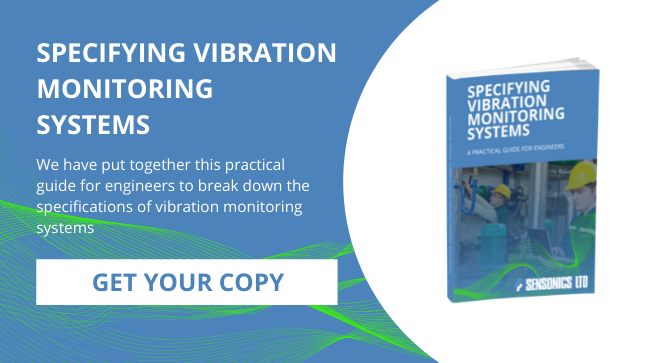The 5 Main Types Of Velocity Vibration Transducers
Velocity vibration transducers - also referred to as velocity sensors - are essential condition monitoring tools that help to ensure the safety, reliability, consistency, performance and the efficiency of rotating equipment. They do this by measuring the absolute vibration in terms of velocity on the bearing housing/machine casing.
The correct installation of the sensor, whether it’s an accelerometer or a velocity transducer, is key as poor installation can render the sensor output unreliable or even unusable - our product O&M handbooks, which are available for you to view on request, cover this aspect in detail. Correctly installed sensors allow both automated and manual monitoring systems to actively respond and apply controls based on accurate machine vibration levels and in turn it’s condition. Here's a quick guide to the main types of velocity sensor:
Types Of Velocity Sensor
1) Moving Coil Type Velocity Vibration Transducer
Moving coil velocity sensors are self-powered devices that produce a dynamic velocity signal in the form of a voltage output. The signal is generated as the coil is moved over a magnet, with the sensor recording the relative vibrations produced. Moving coil sensors are the original type of vibration transducer. They can be connected to Machine Monitoring Systems (MMS) to provide machine protection, or Condition Monitoring Systems (CMS) for vibration analysis.
Details of the Sensonics VEL/G Moving Coil Vibration Transducer can be found here.
2) Linearised Moving Coil Type Velocity Vibration Transducer
These devices are like the moving coil transducers described above but come with additional output linearisation circuitry to provide an extended low-end frequency response, making them ideal for low-speed machines. Unlike standard moving coil transducers, these are two-wire IEPE devices, powered through a constant current circuit.
Find out more about the Sensonics VEL/GLF Linearised Moving Coil Transducer by clicking here.
3) Moving Coil Type Velocity Vibration Transmitter
A moving coil velocity vibration transmitter is a moving coil velocity transducer that’s equipped internally with signal conditioning circuitry to provide a 4-20mA analogue process output for direct connection to a plant’s Distributed Control System (DCS), Supervisory Control & Data Acquisition (SCADA), Programmable Logic Controller (PLC), or Building Management System (BMS) without employing a more costly separate machine monitoring or protection system in between.
The direct 4-20mA output from this two-wire loop powered moving coil device provides cost-effective DC overall level vibration information that is quite sufficient for some requirements, however, this does not allow for more detailed vibration analysis. Where desired the device can be ordered as a three-wire device to include an optional second output in mV/mm/sec AC alongside standard mA/mm/sec DC output. This dynamic AC output can be utilised for more detailed vibration analysis purposes either by permanent connection to an online vibration CMS system or periodic connection to a portable vibration data collector/analyser.
With excellent noise immunity, the moving coil vibration transmitter offers outstanding high frequency vibration rejection and a high tolerance to mains interference that can sometimes be encountered with piezo-electric vibration transmitters.
Click here to find out more about the Sensonics VEL/GDC Moving Coil Transmitter.
4) Piezo-electric Type Velocity Vibration Transducer
A piezo-electric velocity vibration transducer is an accelerometer with an added stage of integration on the internal PCB circuitry that provides a direct dynamic velocity signal output as a voltage (mV/mm/sec). These transducers are usually two-wire IEPE devices that are voltage powered through a constant current circuit, although some older types are three or four wire devices that require a separate positive or negative power supply. Piezo-electric velocity vibration transducers can be connected to a plant’s machine vibration monitoring and protection system (VMS) and/or an online vibration condition monitoring system (CMS) or periodic connection to a portable vibration data collector/analyser. A benefit of piezo-electric vibration transducers (and transmitters) is that they tend to be considerably smaller in size, weight and purchase price when compared with moving coil devices.
Information about the Sensonics PZV Piezo-Electric Velocity Vibration Transducer can be found here.
5) Piezo-electric Type Velocity Vibration Transmitter
The option with the lowest system purchase price is the piezo-electric type velocity vibration transmitter. Like the moving coil transmitter, it provides the same direct 4-20mA output but is also a two-wire loop powered device provides DC overall level vibration information. Its design is intended for direct connection to a plant’s Distributed Control System (DCS), Supervisory Control and Data Acquisition (SCADA), Programmable Logic Controller (PLC), or Building Management System (BMS) without employing the more costly separate machine monitoring or protection system in between.
As per the moving coil velocity vibration transmitter this piezo-electric velocity vibration transmitter is available as a three-wire dual output option called PZDC2 that includes a second output in mV/mm/sec AC alongside standard mA/mm/sec DC output. Again, this dynamic AC output can be utilised for more detailed vibration analysis purposes either by permanent connection to an online vibration CMS system or periodic connection to a portable vibration data collector/analyser.
Click here to find out more about the Sensonics PZDC Two-Wire (24c DC Power) Transmitter.
Velocity Vibration Transducers/Transmitters from Sensonics Ltd.
As an OEM Sensonics manufactures, supplies, installs and maintains transducers and machine protection instrumentation for the measurement of vibration, temperature, position, and shaft speed, supported across the globe from our UK HQ together with our regional partners. For advice or a no obligation quote, please get in touch today, we’d be delighted to help you.
Image Source: Unsplash



